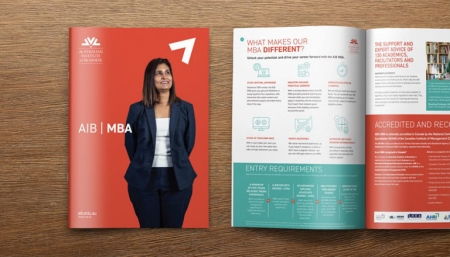Everything You Need To Know About Academic Referencing

Throughout business school, academic referencing is one of those time consuming but essential steps of finalising an assignment. The vast majority of postgraduate work should conclude with a reference list that acknowledges the sources that were used to compile the assessment. AIB expects both students and staff to display high standards of academic integrity, and accurate academic referencing is a large focus of this conduct. AIB students should refer to the AIB Style Guide when referencing material in all instances where the ideas are not their own. This includes paraphrasing, direct quoting and summarising the work of others.
Why it’s important
In academia, it is the norm to use other people’s work to then build on and present original thoughts and ideas. When academic referencing is adhered to, it demonstrates the breadth of background research that has gone into an assignment. It strengthens an academic argument through showing the reader the source of any information that is quoted, as well as verifying data. It also gives the original author credit for his or her work as a leader in that particular field. It’s an essential part of business school, necessary to achieving good results and to enable the reader find the original source of information if required.
Referencing at ‘the practical business school’
Although AIB is known as ‘the practical business school’, this does not mean that important academic practices such as referencing are not used. From a practical perspective, advanced research and referencing skills are certainly useful in the business environment. Therefore, being able to identify reputable sources of information and build an argument based on evidence is a useful skill for professionals to have. Whether it’s in the workplace or in academia, whenever you use someone else’s opinion or theory, it’s important to remember that you are using their intellectual property. As such, they should be appropriately acknowledged.
Practical referencing tips
There are some simple tips that apply to academic referencing at AIB which will help ensure that referencing is up to the required standard. All referencing must be consistent across the assignment or report, and come from credible sources such as academic texts, professional journals or formal reports. At AIB, an author-date referencing system is used which includes both in-text citations and a reference list. The reference list should be in alphabetical order by author surname, and include all details of each publication referenced in the text.
For an MBA assignment, 6-12 credible references should be used, and for major projects this should be 20-25. It’s important to understand that a reference list is not the same as a bibliography, and AIB students are required to use a reference list only. Referencing with footnotes is also not recommended.
Avoiding plagiarism
If there is little or no referencing in an assignment, yet other sources of information have been used, this is likely to be considered plagiarism. This means that you have written in a way that portrays someone else’s ideas, theories or quotes as ‘your own’ – when really, they are not. At AIB, plagiarism constitutes serious academic misconduct, so students are strongly advised to follow good referencing practices in all assignments and project work.
We’re here to help
For those not familiar with academic referencing, it can seem a little overwhelming at first. At AIB, our team of Academics are on hand to assist with any questions you may have. They can run students through the important process, all the way through to referencing for a specific source. Good academic conduct is something that is valued very highly at AIB, so don’t avoid referencing – seek help if you’re unsure and we’ll guide you through the process.
What do you think?
Do you have any tips for current business school students for when it comes to academic referencing? While it can be time consuming, it adds significant value to each assessment, and prevents any academic misconduct taking place. I’m keen to hear what you think, comment your views below to join the conversation.
This article was written by Laura Hutton on behalf of the Australian Institute of Business. All opinions are that of the writer and do not necessarily reflect the opinion of AIB.





